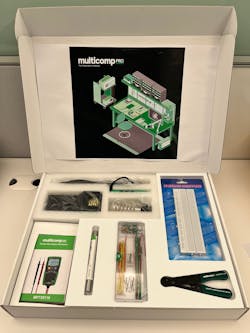This article is part of a series. Read Part 1 and Part 3.
With so many components required to produce electronic products, sourcing each part can waste time and complicate the design process. In this second article in our series, we explore how developers can benefit from sourcing kits that include all of the components needed to complete a product—from the design phase through to the prototype and low- to mid-volume production.
Above all else is the economic advantage. When creating a new product, developers often waste valuable time sourcing and placing orders, waiting for deliveries, and stocking inventory for everything from the first prototype to full production builds. Kitting operations from a distributor can help streamline these processes to make manufacturing more time- and cost-effective.
Outsourcing the purchasing and packaging of components to a knowledgeable distributor simply saves money by eliminating the complexities of sourcing. Using the proper distributor will allow you to eliminate minimum order quantities so that you can avoid excess inventory. The kitting team also could suggest form/fit/function alternatives to decrease lead times and lower costs. That’s because trying to deal with different parts is the biggest pain point in procuring components.
Furthermore, custom kitting can help when supply-chain woes impact product availability. There are always part shortages in this industry. Trusted distributors have access to multiple products from multiple vendors, and they can source alternative suppliers when certain inventories dry up.
Similarly, distributors have an advantage when the developer’s design requires an uncommon or niche product that may not have high demand. Distributors can access hard-to-find components when creating custom kits for their customers. It may be as simple as a developer needing custom-cut wires with connectors, special harnesses, or even products with a unique color.
Optimal Logistics
Improving space and logistics can be another benefit of kitting operations. If the developer is doing multiple production runs over time, kitting could save space and money by letting the distributor hold the inventory in prepackaged kits on its premises for the developer.
That, in turn, improves the logistics of production by enabling just-in-time manufacturing, having the components delivered on demand in only the quantities needed to support a production run. Not only does this approach elevate the developer’s capabilities, but it also can eliminate the need for added purchasing resources.
In addition, kitting may benefit businesses that have inconsistent product requirements. Many times, businesses require a certain grouping of components occasionally, but not regularly. For example, they may need certain products for a new store opening but will not have much demand for them later. Businesses could prepackage custom kits for these occasional needs.
Post-production, custom kitting can be an asset for scheduled maintenance. Some products designed by developers require regular maintenance that often includes swapping out parts. Distributors could build kits that are delivered labeled and kitted to the developer’s requirements for ease of receiving.
To simplify ordering, developers can ask their distributor partner to create a dedicated part number for a custom kit. The purchasing staff no longer needs to maintain a list of all required part numbers, making it easier to procure products.
And, lastly, custom kitting alleviates uncertainties in design and production processes. A trusted distributor partner can offer developers a higher level of expertise and knowledge because they typically have specialists across all product categories.
Developers can leverage that expertise to ensure they’re procuring the best products for their design or to find suitable alternatives when inventories are low. Distributors meticulously check each kit component against the bill of materials, check for quantities, and examine them for quality control.
Final Thoughts
Whether a bill of materials consists of five or 500 parts, individually sourcing and managing each item can be time-consuming and nerve-racking. Newark’s custom kitting services help place orders faster and easier, giving developers more time to focus on what really matters—their next design.
This article originally appeared on ElectronicDesign.com.










